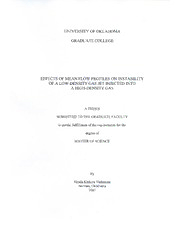
Effects of Mean Flow Profiles on Instability of a Low-Density Gas Jet Injected into a High-Density Gas PDF
Preview Effects of Mean Flow Profiles on Instability of a Low-Density Gas Jet Injected into a High-Density Gas
Abstract The objective of this study was to investigate the effects of the mean flow profiles on the instability characteristics in the near-injector region of low-density gas jets injected into high-density ambient gas mediums. To achieve this, a linear temporal stability analysis and a spatio-temporal stability analysis of a low-density round gas jet injected vertically upwards into a high-density ambient gas were performed by assuming three different sets of mean velocity and density profiles. The flow was assumed to be isothermal and locally parallel. Viscous and diffusive effects were ignored. The mean flow parameters were represented as the sum of the mean value and a small normal-mode fluctuation. A second order differential equation governing the pressure disturbance amplitude was derived from the basic conservation equations. The first set of mean velocity and density profiles assumed were those used by Monkewitz and Sohn (1988) for investigating absolute instability in hot jets. The second set of velocity and density profiles assumed for this study were the ones used by Lawson (2001). And the third set of mean profiles included a parabolic velocity profile and a hyperbolic tangent density profile. The effects of the inhomogeneous shear layer and the Froude number (signifying the effects of gravity) on the temporal and spatio-temporal results for each set of mean profiles were delineated. A decrease in the density ratio (ratio of the density of the jet to the density of the ambient gas) resulted in an increase in the temporal amplification rate of the disturbances for the second and the third set of profiles, while the amplification rate for the first set of profiles was decreased. The reason for this inverse behavior with the first set of profiles is not clear. The phase velocities of the disturbances for all the three sets of profiles were decreased as the density ratio was reduced. The temporal growth rate of the disturbances for all the three sets of mean flow profiles was increased as the Froude number was reduced indicating the sabotaging effect of gravity. The spatio-temporal analysis was performed to determine the absolute instability characteristics of the jet for the three sets of profiles. At a large Froude number (negligible gravity), a critical density ratio was found for the three profiles at which the jet became absolutely unstable. The critical density ratio for the first and the second set of profiles was almost equal (S = 0.515 and S = 0.525 c c respectively). The critical density ratio for the third set of profiles was higher (S = c 0.843). The reason could be that the third set of profiles includes a parabolic velocity profile, with a steep velocity gradient in the central region of the jet. A critical Froude number was found for the three sets of profiles, below which the jet was absolutely unstable for all the density ratios less than unity. The critical Froude number for the first and the second set of profiles was almost equal (Fr = 1.83 and Fr = 1.58 respectively). The critical Froude number for the third set of profiles (Fr = 3.74) was higher. For all the profiles, the critical Froude number demarcated the jet flow into the momentum-driven regime and the buoyancy-driven regime similar to the Strouhal number regimes observed by Subbarao and Cantwell (1992).
